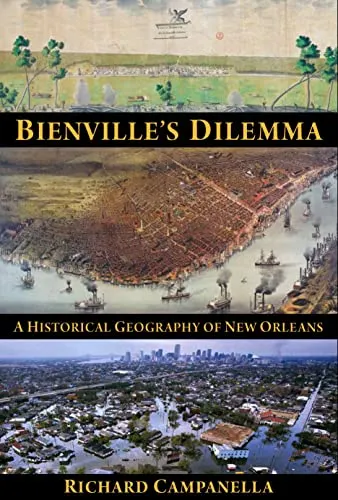Search
[{{{type}}}] {{{reason}}}
{{/data.error.root_cause}}{{{_source.title}}} {{#_source.showPrice}} {{{_source.displayPrice}}} {{/_source.showPrice}}
{{#_source.showLink}} {{/_source.showLink}} {{#_source.showDate}}{{{_source.displayDate}}}
{{/_source.showDate}}{{{_source.description}}}
{{#_source.additionalInfo}}{{#_source.additionalFields}} {{#title}} {{{label}}}: {{{title}}} {{/title}} {{/_source.additionalFields}}
{{/_source.additionalInfo}}Bienville's Dilemma
There are many famous cities in North America. Places like New York or Chicago would spring to mind if referring to the northern United States. However, one very key city for the South is, much to my own surprise, New Orleans. Being the linchpin of Louisiana's river and ocean access, this isn't that surprising. In Richard Campanella's "Bienville's Dilemma," he explains why New Orleans is a key city to learn about to understand a key portion of American history.
As to why the title of the book is called such, it is so named after Jean-Baptiste Le Moyne de Bienville, the founder of the area that was called New Orleans in the New World. That explains the first half of the title. The second part, the "dilemma", stems from the fact that the new city was to be placed on grounds that were both fertile for commerce and dangerous for other reasons. The swampy backlands and the easily flooded plains made New Orleans both lucrative for its dominance over the nearby rivers and oceanic access and dangerous due to potential flooding.
It's from this foundation that the book segues into discussing the history, geography, demographics, and other related subjects that comprise a broad base of historical information germane to the subject of New Orleans. Campanella then sets out, in a time period stretching from the first discovery of New Orleans to just after the disastrous Hurricane Katrina of 2005, to expound on the historical significance and impact of New Orleans.
Over the space of 400 pages, this text consists of a series of chapters breaking down the history of New Orleans. Ranging from geological data to a discussion of the demographics of its residents and major historical events key to New Orleans's development, this book serves as a broad historical overview of New Orleans as a historical topic.
I found the prose to be straightforward and easy to read. This is a somewhat weighty text, and it does come with various images and charts to illustrate many of its finer points. It's not aimed at a casual reader, though for any serious student of American history, this is an excellent text for a broad-based overview of the history of New Orleans.
I had three takeaways during my own reading. New Orleans is geologically risky in location, though it balances out its easy flooding chances with lucrative river and ocean trade access, forming a key artery of American nautical commerce. Demographically, New Orleans remains, despite recent shifts, a very diverse blend of various cultures and ethnic groups. Finally, while this book ends just after 2005, it's still a rich source of aggregated data on New Orleans for anyone who wishes to know about its history.
If you want a more casual read, this is not the first book I recommend. If you are a dedicated American history student, though, this book comes very highly recommended.
This text is available in paperback on Amazon.
(Amazon Affiliate Link)
When you subscribe to the blog, we will send you an e-mail when there are new updates on the site so you wouldn't miss them.








Comments